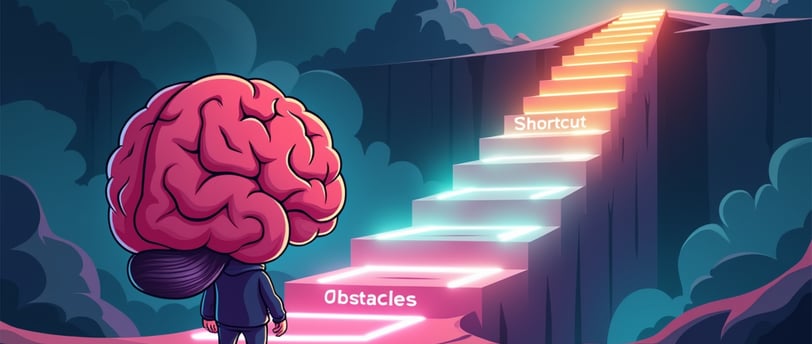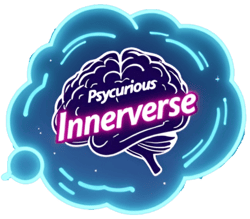The Brain’s Secret Shortcut You Never Knew About
Did you know your brain is constantly streamlining your thought processes? This fascinating mechanism, called a mental shortcut or heuristic, helps you make quick decisions by relying on past experiences and learned patterns. Here, we’ll explore how these shortcuts work, their benefits for creativity and problem-solving, and the hidden risks they pose. By understanding your brain’s secret shortcuts, you can transform them into tools for sharper thinking and better decision-making.
1/2/20257 min read


The Brain’s Secret Shortcut You Never Knew About
Modern life seems to move at a relentless pace. We juggle multiple responsibilities, stay connected through buzzing smartphones, and often rush from one task to another. In the midst of this hectic routine, it’s easy to overlook just how complex our brains truly are. Housing billions of neurons and trillions of connections, the brain functions as the most intricate organ on the planet. But here’s the twist: despite this incredible complexity, your brain also craves efficiency. It’s always looking for ways to save time, conserve energy, and make decisions more quickly. Enter the concept of “brain shortcuts”—an in-built mechanism that helps you streamline your thought processes and navigate life’s challenges without overloading. In this article, we’ll dive deep into what these shortcuts are, how they form, why they’re both brilliant and risky, and how you can harness them to become a better thinker and decision-maker.
1. Understanding the Hidden Shortcut: Heuristics
In everyday conversation, we often describe ourselves as “creatures of habit.” Indeed, repetition and routine guide a large portion of our behavior. However, behind these habits lie subtle processes in the brain called heuristics. A heuristic can be thought of as a mental shortcut or rule of thumb that enables us to make quick judgments and decisions. Psychologists have studied heuristics for decades, with renowned researchers like Amos Tversky and Daniel Kahneman famously examining how these shortcuts influence judgment and decision-making.
Why do heuristics exist? Simply put, your brain operates under the principle of cognitive efficiency. If you had to deeply analyze and deliberate over every decision—whether it’s picking a brand of cereal or deciding how to cross a busy street—you’d be paralyzed by analysis. Instead, heuristics allow your mind to form “best guesses” based on past experiences, patterns, and learned associations. This saves time and mental energy, which can then be channeled into situations that truly require deeper thought.
Key takeaway: Heuristics are your brain’s built-in shortcut system, ensuring you’re not bogged down by trivial decisions. Rather than reinvent the wheel each time, your mind learns from repetition and past experience, creating pathways that accelerate problem-solving.
2. The Neuroplasticity Connection: Building Better Pathways
The brain’s ability to reorganize itself—termed neuroplasticity—lies at the core of these shortcuts. Neuroplasticity explains how habits are formed and why certain connections in the brain become quicker and more robust with repeated practice. Think of the brain like a vast city of highways. Each piece of information (traffic) travels through these highways (neural pathways). The more a specific route is used, the more “paved” it becomes, eventually turning into a neural superhighway.
Imagine learning to ride a bicycle: at first, you wobble, fall, and struggle. Over time, repeated practice paves a sturdy neural highway for balance and coordination. Eventually, riding becomes automatic. That same principle applies to everything from recognizing faces to solving math problems. Over months and years, your brain’s pathways are shaped by frequent usage, enabling you to perform tasks rapidly and sometimes subconsciously.
Key takeaway: Neuroplasticity ensures that the brain’s shortcuts aren’t static—your mental pathways adapt and evolve based on how you use them. The more you engage in a certain activity or type of thinking, the more efficient your brain becomes at it.
3. Surprising Benefits of Brain Shortcuts
While a “shortcut” sometimes implies cutting corners or producing lower-quality results, in the world of cognition, these shortcuts can be extraordinarily beneficial. They serve a variety of important functions:
Quick Response in Emergencies
Imagine you’re walking in the woods and you catch sight of a slithering movement near your feet. You don’t wait to confirm the species of the snake—you immediately jump back. The heuristic “snake equals danger” helps you avoid potentially life-threatening situations. In such scenarios, speed is more critical than detailed analysis.Pattern Recognition
Your ability to spot patterns quickly—from noticing a friend’s face in a crowd to recognizing a good deal when you see one—relies heavily on heuristics. Your brain searches its mental library of past experiences, matching new input to something familiar. This pattern recognition can be invaluable in fields like data analysis, medicine, or even sports.Creativity and Innovation
Interestingly, shortcuts can also fuel creativity. By linking seemingly unrelated bits of information, your mind can generate fresh insights or innovative solutions. For instance, you might draw on a familiar concept from architecture to solve a design challenge in software engineering. Psychologist Dr. Teresa Amabile of Harvard Business School notes that many creative sparks happen when existing knowledge in one domain is suddenly applied to a new context.
Key takeaway: Brain shortcuts aren’t just about speed; they empower us to respond to critical situations, recognize patterns, and even forge the creative leaps that fuel innovation.
4. The Downside: Biases and Flawed Thinking
As extraordinary as these shortcuts are, they come with pitfalls. Sometimes, your brain overplays its hand, applying a shortcut inappropriately. This shows up as cognitive biases—systematic errors in reasoning. If you’ve ever found yourself stubbornly clinging to a viewpoint despite evidence to the contrary, you’ve experienced one of these biases firsthand.
Confirmation Bias: You look for evidence that validates what you already believe, ignoring or dismissing contrary data.
Availability Heuristic: You judge the likelihood of an event based on how easily an example comes to mind. If you’ve recently seen news about plane crashes, you might suddenly overestimate the danger of air travel, even though statistically it’s very safe.
Anchoring Bias: The first piece of information you receive sets the “anchor,” and you revolve subsequent decisions around it, even if the anchor is inaccurate or irrelevant.
Such biases underscore that brain shortcuts, while powerful, can become blind spots that undermine clarity.
Key takeaway: Shortcuts like heuristics save time and mental effort, but they also invite cognitive biases that can distort our judgment. Recognizing these pitfalls is crucial to using shortcuts effectively.
5. Harnessing Your Brain’s Secret Shortcut
1. Practice Mindfulness
Mindfulness helps you step back from autopilot thinking. By cultivating self-awareness—through meditation, deep breathing, or simply pausing to reflect—you create space to question your brain’s fast-track decisions. According to research published in Frontiers in Psychology, mindful practices can help people resist confirmation bias and re-evaluate their initial judgments.
2. Stay Curious and Seek Novelty
Learning new skills, exploring fresh ideas, and challenging your comfort zone strengthen and diversify your neural pathways. This expanded mental terrain promotes richer heuristic patterns, making your shortcuts more adaptable rather than rigidly predictable.
3. Deliberate Practice
High-speed decisions aren’t merely about innate talent; they’re also about repeated exposure. By training systematically—whether through playing musical scales, solving math puzzles, or rehearsing presentations—you reinforce neural circuits. Over time, routine tasks require less conscious effort, freeing your mind for more complex or creative endeavors.
4. Check Your Biases
When you sense a quick, gut-level response, pause to ask yourself: “Am I falling into a bias?” Over time, practicing this mental check can mitigate the risk of shortcuts leading you astray.
6. Beyond Survival: Why Our Brain Likes Efficiency
Historically, speed and efficiency were directly tied to survival. Early humans who quickly recognized threats or found resources were more likely to thrive. But in our modern era, where immediate physical threats are less common (though still possible), these same shortcuts have evolved to tackle new challenges—from deciphering massive streams of information online to negotiating the complexities of social media.
Furthermore, efficiency plays a role in creativity. With so much of our environment automated or managed by technology, your brain now has the luxury of exploring new possibilities. Dr. Mihaly Csikszentmihalyi, known for his work on “flow,” explains that once certain tasks are streamlined mentally, we’re freed to direct more mental energy toward imaginative or higher-level pursuits.
7. A Word of Caution: When Shortcuts Become Crutches
As you revel in your brain’s remarkable capability to fast-track decisions, remember that shortcuts can breed complacency. If you rely too heavily on mental heuristics, you might overlook crucial details or nuance. The key is balance: trusting your intuition when it’s well-informed but also verifying facts and exploring second opinions when decisions carry high stakes. Overconfidence in your neural “fast lane” can lead to oversights in judgment, with consequences that ripple into your personal, professional, or academic life.
8. The Bigger Picture: Embracing Your Brain’s Potential
When you examine the brain’s shortcuts, a striking truth emerges: you are never a passive passenger in your own cognition. By understanding heuristics, you gain insights into why you default to certain assumptions, how you form habits, and why some creative sparks fire without conscious effort. It’s akin to learning the secret blueprint of your mind’s operating system. And armed with this knowledge, you can take deliberate steps to refine your thinking, improve decision-making, and foster deeper creativity.
Practical Steps to Move Forward
Identify Patterns: Start a daily or weekly journal where you note down significant decisions and reflect on whether you used a quick shortcut or a deliberate thought process.
Build a Bias Checklist: From confirmation bias to anchoring, keep a short list of common biases handy. Refer to it when making important decisions.
Engage in Brain-Expanding Activities: Take up a new language, explore puzzles, or enroll in an online course. Diversifying your mental exercises builds stronger, more flexible neural highways.
Conclusion: The Shortcut as a Pathway to Mastery
Your brain’s shortcuts reflect the incredible efficiency and adaptability that evolution instilled in you. While they can mislead you through biases, these mental “fast lanes” are also capable of remarkable feats—enabling rapid, almost intuitive problem-solving, pattern recognition, and even sparks of creativity. By being mindful of the pros and cons of this system, you can strike a healthy balance: trusting these mental shortcuts when they serve you well, and double-checking them when the stakes are high. In doing so, you’ll unlock a profound sense of mastery over your own thought processes.
Remember: Understanding your brain’s secret shortcut isn’t about eliminating it; it’s about embracing its potential while staying aware of its pitfalls. With curiosity, practice, and self-reflection, you can transform these shortcuts into powerful tools, guiding you toward a more insightful, efficient, and creative way of engaging with the world.
Further Reading & References
Thinking, Fast and Slow by Daniel Kahneman: A deep dive into heuristics and biases.
The Power of Mindful Learning by Ellen J. Langer: Explores the role of mindfulness in everyday cognitive functions.
Neuroplasticity studies in journals like Nature Reviews Neuroscience provide insights into how the brain rewires itself through repeated practice.
Liked This Article?
Share it with someone who’s fascinated by the human mind’s hidden powers.
Comment below with your experiences, successes, or struggles related to mental shortcuts.
Subscribe to our blog or channel for more explorations into psychology, neurology, and the boundless universe within your mind. Because the more we learn about our own thinking, the more equipped we become to innovate, grow, and truly thrive.
References & Citations:
"Thinking, Fast and Slow" by Daniel Kahneman – Understanding mental shortcuts and cognitive biases. https://amzn.to/3BHNHV8
“Atomic Habits: Tiny Changes, Remarkable Results” by James Clear. https://amzn.to/4fAcGaE
"The Predictive Brain" – Research from the Journal of Cognitive Neuroscience on how the brain anticipates outcomes.
"How Neural Pathways Work" – Scientific American, exploring brain efficiency mechanisms.
"Cognitive Load Theory and Working Memory" – ResearchGate article by John Sweller on how the brain simplifies learning.
"The Science of Creativity" – Studies from the National Institutes of Health on cognitive flexibility and shortcuts.
